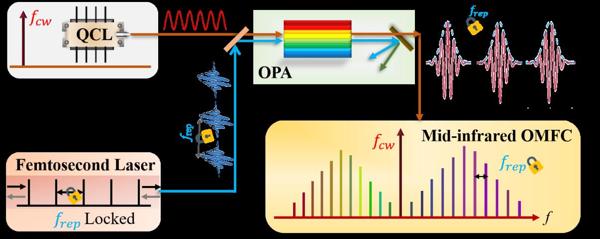Spectral measurements of molecular fingerprint features are of great significance, which establish the microscopic structures and material compositions. Therefore, a higher request in the measurement resolution, precision, and sensitivity is put forward.
In all the spectral domains, most molecules have strong fundamental vibrational transitions in the mid-infrared region. Broadband mid-infrared molecular spectroscopy is of great interest in many applications, including environment monitoring, combustion diagnosis and biomedicine
Optical frequency combs (OFCs) with high frequency resolution and precision have made great progress in the recent decades and innovated the traditional spectral measurement techniques due to the evenly spaced hundreds of thousands of narrow-linewidth teeth. By utilizing two coherent OFCs to replace the traditional Flourier interferometers, the spectral resolution, measurement speed, and sensitivity are tremendously improved without traditional mechanical scanning devices.
However, traditional DCS schemes require the use of bulk sophisticated control systems to achieve the high coherence, but often at the cost of complexity and the demand of the well-maintained laboratory environments, which limit the development of DCS in field applications. To promote the development of fieldable DCS, more efforts should be applied to achieve mid-infrared DCS with a broadband spectral range and robust structure.
To solve these problems and drive the DCS into practical applications, the research group led by Prof. Wenxue Li from State Key Laboratory of Precision Spectroscopy, East China Normal University, reported the generation of broad mid-infrared DCS with highly passive mutual coherence and robustness based on the novel concept of optical-optical modulated OFC, which had been demonstrated in their previous works.
The studies on the absorption spectral measurement of multiple molecular species, including C2H2, CH4, H2CO, H2S, COS, and H2O, were performed to verify the capability and sensitivity for broadband molecular spectroscopy. The research results are published in Photonics Research, Volume 9, No. 7, 2021 (Zhong Zuo, Chenglin Gu, Daowang Peng, Xing Zou, Yuanfeng Di, Lian Zhou, Daping Luo, Yang Liu, Wenxue Li. Broadband mid-infrared molecular spectroscopy based on passive coherent optical–optical modulated frequency combs[J]. Photonics Research, 2021, 9(7): 07001358).
In this scheme, a mid-infrared continuous-wave (CW) laser is pulsed and power amplified through a nonlinear optical parametric amplification process. The generated mid-infrared pulses exhibit well comb-resolved structures, which inherit the operating frequency of the CW laser and the frequency spacings of which equal to the repetition frequency of the pump source, as shown in Fig.1.

Fig.1 Schematic of an individual mid-infrared optical-optical modulated OFC.
As a result, the scheme achieves the generation of passively coherent mid-infrared DCS without active carrier envelop phase-locking processes when the repetition frequency of pump sources is under control.
The parallel detection of multiple molecular species was carried out in the experiment. The frequency resolution came up to 108 MHz, which has outperformed the high-performance mid-infrared Fourier-transform spectrometers.
Meanwhile, the 1-σ sensitivity of H2CO (one of the hazardous gases in the indoor air) was measured to be ~0.04 ppm exceeding the permission concentration level of 0.08 ppm ruled by the US Department of Health and Human Services in 2011.
The high sensitivity of the reported mid-infrared DCS would promote the reformation of the exhaust emission standards in many fields, such as the industry production, turbine engines, vehicles, and so on. Besides, the performance of the mid-infrared DCS has also been demonstrated in a noisy environment to measure the exhaust gas of an operational engine.
Compared to the traditional schemes of mid-infrared DCS, the optical-optical modulated DCS with relatively simple structure and high robustness achieves the high precise spectral measurement, which has the potential for fieldable applications.
The article reports the generation of broadband mid-infrared DCS with built-in coherence, which can be used for various applications, such as trace gas analysis, and combustion diagnosis. More importantly, the scheme with excellent spectral tunability can be applied into the generation of far-infrared and terahertz DCS by replacing appropriate CW lasers, which will benefit the development of DCS field and be devoted to more applications, especially for the biomedicine.


